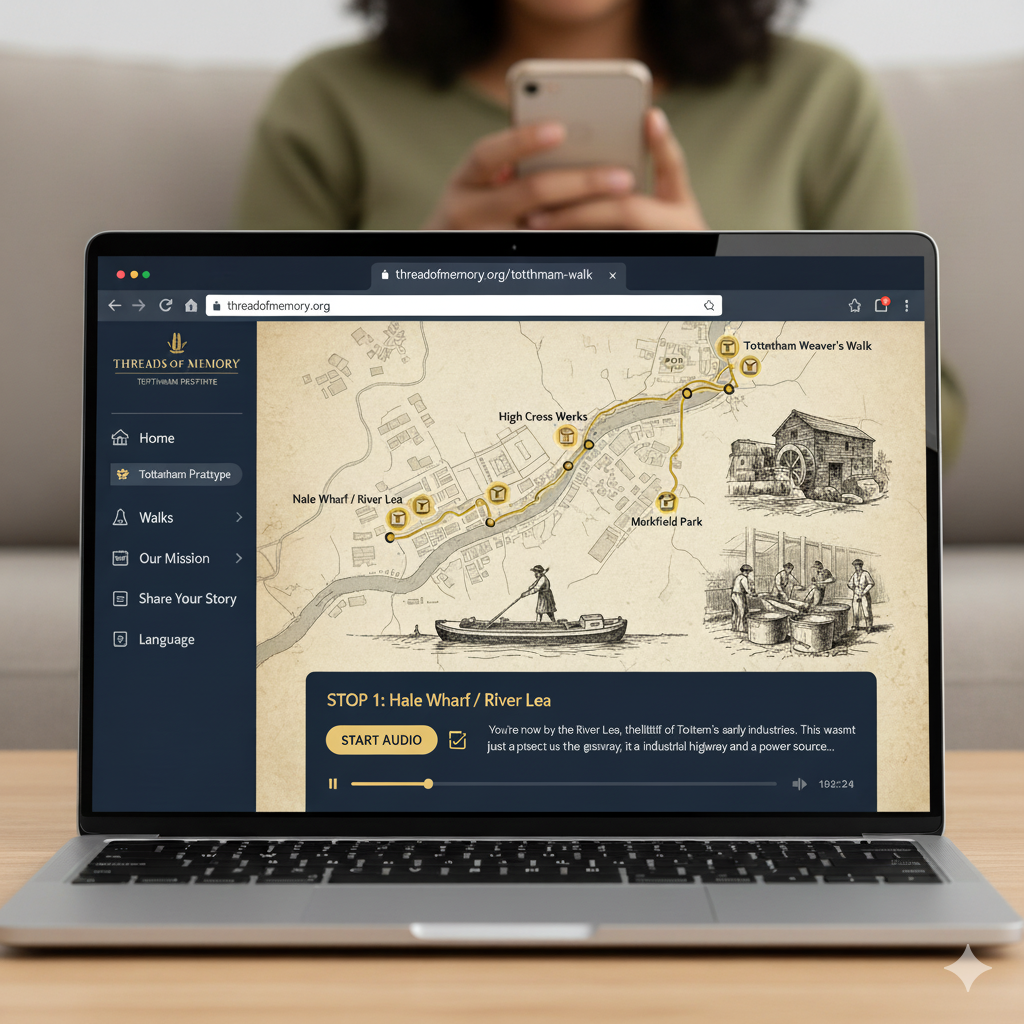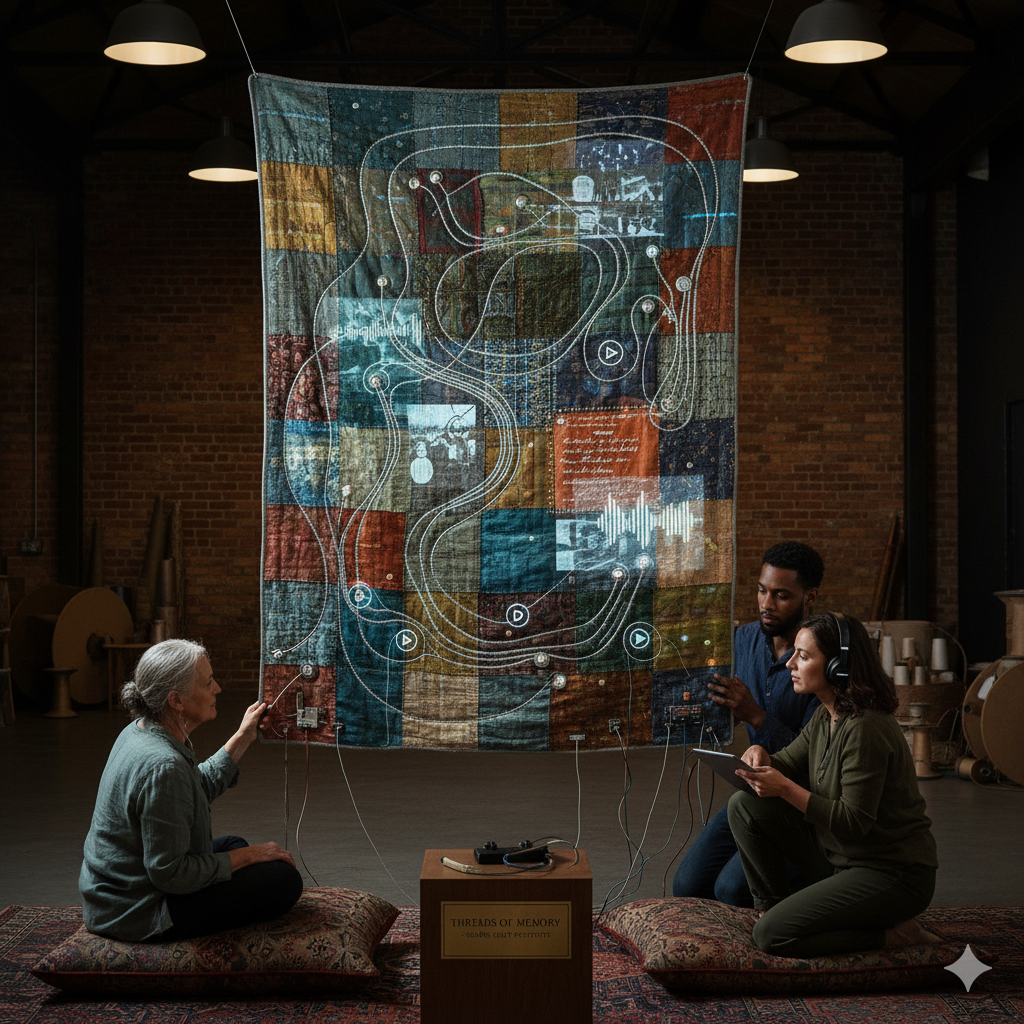On this page
Threads of Memory
An immersive arts experiment weaving textile heritage with sound and spatial media.
One‑liner: Community stories become “threads” that you can hear, touch, and navigate—both in a physical installation and in a lightweight VR scene.
Project Overview
Threads of Memory gathers oral histories, textiles, and ambient field recordings from North London communities and maps them to a shared, open VR archive. Each story thread unlocks a tactile artefact in the physical installation and a corresponding interactive environment online.
- Where: Haringey / Tottenham and nearby communities.
- Why: Prototype new ways to preserve, play, and pass on local culture using accessible tech.
- How: Lo‑fi to hi‑fi prototyping; publish Lab Notes and templates for others to remix.
Phase One: An Immersive Weaver Line
What we’re testing
- Immersive Audio Walk — a QR‑linked web app that layers oral histories, archival sound (e.g., loom machinery), and site field recordings along the Weaver Line. (Hosted on a lightweight stack; phone‑friendly; captions + transcripts.)
- Craft + Story Workshops — community sessions where residents share sewing/weaving practices while recording short oral testimonies. (Lo‑fi, multilingual where possible; simple tools like Zoom H1n + Audacity.)
- Sound Quilt Prototype — a 2×2m projection‑mapped fabric panel with one interactive sensor (Makey Makey + conductive thread). Touch/stitch triggers reactive audio in MAX/MSP or TouchDesigner. (Small‑scale, affordable testbed.)
Why this approach
- Artist‑led testbed, not a finished artwork.
- Audience testing is embedded (walk pilots, workshop feedback, quilt interactions).
- Knowledge sharing via Rainforest Studio Lab Notes.
- Scalable insights for future public programmes and community use.
Audience & testing
- Focus: Bruce Grove + Seven Sisters communities; prioritise women and migrant makers.
- Methods: short surveys, facilitator notes, oral feedback; what we’re learning → shapes whether to scale the walk, the quilt, or a hybrid.
Access & inclusion
- Captions + large‑print transcripts for audio.
- Tactile interaction on the quilt for non‑visual access.
- Free workshops in familiar community spaces; translation support where possible.
Roadmap
- Prepare — visuals, mockups, and collaborator convening.
- Prototype — audio walk + quilt sensor test; internal iterations.
- Engage — community workshops + public pilots; collect feedback.
- Publish — interim Lab Notes; refine; share methods pack.
Goals
- Build a story loom pipeline: collect → annotate → stitch audio/textile → publish to VR.
- Run co‑creation sessions with elders, youth, and makers.
- Ship an accessible demo (web + headset‑optional) with alt text, captions, and keyboard support.
- Document methods openly (guides, checklists, and facilitation kits).
Prototype visuals


Accessibility (baked‑in)
- Alt text + transcripts; clear focus states; reduced‑motion mode.
- Lo‑fi physical interfaces for events (large‑type labels, tactile affordances).
- Plain‑language instructions; content warnings where relevant.
Tech & Methods
- Eleventy, A‑Frame, web audio; OKLCH color tokens; container queries.
- Rapid prototyping with named AI team‑mates: Codie (dev), Bizzy (product), Nova (innovation), Granty (funding), Ally (accessibility).
- Open documentation via Lab Notes and public repos (where appropriate).
Status
- Now: site scaffold, theme system, initial VR scene ✅
- Next: story collection sprints + first co‑creation workshop ◻︎
- Later: public demo + open methods pack ◻︎
Collaborators & interest
- We welcome expressions of interest from local makers, textile artists, sound recordists, venues, and community groups.
- Email hello@rainforeststudios.xyz to say hi.